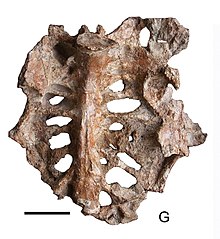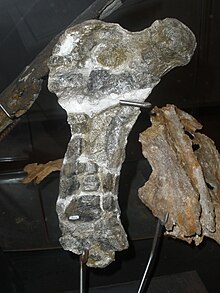Gargantuavis
| Gargantuavis | |
|---|---|

| |
| The holotype of Gargantuavis philoinos, a partial pelvis from Campagne-sur-Aude | |
| Scientific classification | |
| Domain: | Eukaryota |
| Kingdom: | Animalia |
| Phylum: | Chordata |
| Clade: | Dinosauria |
| Clade: | Saurischia |
| Clade: | Theropoda |
| Clade: | Avialae |
| Family: | †Gargantuaviidae Buffetaut and Angst, 2019 |
| Genus: | †Gargantuavis Buffetaut & Le Loeuff, 1998 |
| Species: | †G. philoinos
|
| Binomial name | |
| †Gargantuavis philoinos Buffetaut & Le Loeuff, 1998
| |
Gargantuavis (meaning 'gargantuan bird') is an
Its femur shows that it was a
Discovery

The first Gargantuavis fossil was found in 1995 in
Gargantuavis specimens are known from six localities in Europe:
- The Bastide-Neuve locality, near Fox-Amphoux (Var), yielded the initial specimen reported in 1995, two other partial pelvic fragments (BN 758 and BN 763) described in 2015, and a possible rib fragment found in association with BN 763.[8]
- The Bellevue locality, near Campagne-sur-Aude (Aude), yielded another partial pelvis (MDE C3-525), which was deemed the holotype in the 1998 description of the genus.[1] This site has been dated to the early Maastrichtian, about 71.5 million years ago.[9]
- The Combebelle locality, near Villespassans (Hérault), yielded a large femur lacking the distal end (MDE A-08), which was referred to the genus in its initial 1998 description.[1]
- The Montplo-Nord locality, near Cruzy (Hérault), yielded a single neck vertebra (MC-MN 478) which was referred to the genus in 2013.[10] A synsacrum fragment (MC-MN 1165) and an incomplete left ilium (MC-MN 431), both described in 2016, were also found at this locality.[3] More recently, this site has also yielded a complete femur of 23 cm, belonging to an individual of about 50 kg (110 lb).[11]
- A quarry near the village of age of the late Cretaceous, about 72 to 73.5 million years ago.[13]
- The Hateg Island–yielded a pelvis in 2019. Its discovery here revises earlier ideas of the bird being endemic to the Ibero-Armorican Island.[4]
Description

Though Gargantuavis is only known from a few isolated fossil bones, some information about its life appearance and ecology have been inferred by studying their details. Gargantuavis is known from several specimens representing a few limited parts of the skeleton: synsacra (the fused vertebrae above the hip),[7] ilia (hip bones), at least one cervical vertebra,[10] and two femora (upper leg bone), which was referred to the species based on the fact that it seems to fit well with the hip.[1][11] No cranial remains have been found, so the shape of the head is unknown. However, the only known cervical vertebra suggests that Gargantuavis had a rather long and slender neck, which seems to preclude the presence of a massive skull.[10]
Other than its large size, the most unusual feature of Gargantuavis was its pelvis. It was originally reported to be extremely wide, like that of a
Paleoecology
During the Late Cretaceous, Europe was an
Since no skull remains have been found, the diet of the animal is uncertain.[10] Contrary to the giant terrestrial Cenozoic birds that lived in ecosystems without predators (or including only small carnivores), Gargantuavis cohabited with abelisaurids and dromaeosaurids theropods, so the place of this giant terrestrial bird in the Late Cretaceous ecosystems of the Ibero-Armorican island is unclear. Gargantuavis seems to have been an uncommon part of the fauna in its region. Despite numerous digs at sites where its bones have been found since its discovery, most have yielded only single specimens.[8] Although its fossils are rare, the presence of Gargantuavis from southeastern France to north-western Spain shows that this bird had a wide distribution in the Ibero-Armorican island.[12] It is possible that Gargantuavis lived mainly in an environment that was not compatible with fossilization, such as areas far from the rivers and floodplains, which represent most of the fossiliferous deposits in the late Campanian-early Maastrichtian of France and Spain.[6][8][2]
Bone histology showed that Gargantuavis had a rapid early growth followed by an extended period (of at least 10 years) of slow cyclical growth before to attain skeletal maturity. A similar pattern is known in extinct dinornithiformes and in the extant kiwi, which are also insular birds. The titanosaur Ampelosaurus, found together with Gargantuavis in the Bellevue site, shows also a reduction in its growth rate, possibly linked to some environmental pressure like periodic food shortages. This is supported by sedimentological and mineralogical studies which indicate episodes of semi-arid and strongly seasonal climate during the Late Cretaceous in Southern France.[15]
Classification
The systematic position of Gargantuavis with other birds is uncertain because of the fragmentary nature of its remains.
However, the discovery of a pelvis from what was Hateg Island shows supratrochanteric processes on the femora, a lack of a glycogen body, and a lack of fusion of the pelvic bones around the hip socket, meaning it was not closely related to Ornithurae, and likely not even a member of Ornithothoraces which includes modern birds and their closest ancestors. The archaic Hateg avian theropods Elopteryx and Balaur bear some similarity to Gargantuavis remains, which may indicate the three form some clade native to the Late Cretaceous European archipelago, though they have ambiguous affinities.[4] This was questioned by other authors, and it is claimed that it was a basal ornithurine, at an evolutionary level similar to that of Hesperornithies.[18]
References
- ^ S2CID 128496095.
- ^ a b c d Buffetaut, E.; Angst, D. (2016). "The giant flightless bird Gargantuavis philoinos from the Late Cretaceous of southwestern Europe: a review". In Khosla, A.; Lucas, S.G. (eds.). Cretaceous Period: Biotic Diversity and Biogeography. Albuquerque: New Mexico Museum of Natural History and Science Bulletin 71. pp. 45–50.
- ^ .
- ^ S2CID 210302354.
- ^ .
- ^ a b Buffetaut, E. (2012). "Les oiseaux fossiles du Crétacé supérieur de l'Hérault". Bulletin de la Société d'Étude des Sciences Naturelles de Béziers (66): 34–39.
- ^ S2CID 4306946.
- ^ .
- ^ .
- ^ .
- ^ a b Buffetaut, E.; Angst, D. (2017). "New light on the Systematic Position of the Late Cretaceous Giant Bird Gargantuavis". Zitteliana (15th Annual Meeting of the European Association of Vertebrate Palaeontologists) (91): 26.
- ^ .
- ^ hdl:20.500.12468/573.
- ^ PMID 25610343.
- ^ S2CID 16679045.
- ^ S2CID 198403535.
- ^ Mayr, G., 2009. Paleogene fossil birds. Berlin, Springer.
- ISSN 0195-6671.
